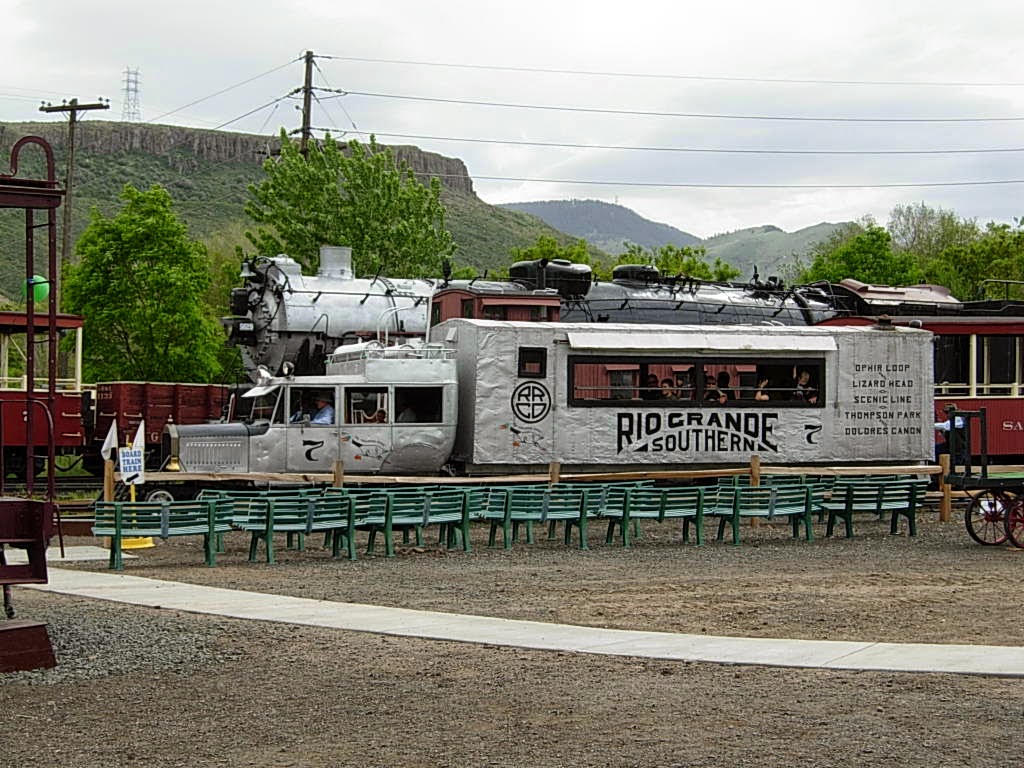Mt. Garfield dominates the skyline as you drive east out of Grand Junction.
The Colorado River valley is broad and green, bordered by rolling hills to the north and south. The dichotomy between the terrain from one side of the road to the other is fascinating.
 |
| To the north/west, the hills are more arid. |
 |
| To the south/east, the vegetation is much more lush. |
Gradually, the hills close in on either side as you approach the spectacular Glenwood Canyon stretch of I-70. Completed only in 1992, it was the last part of the transcontinental interstate system to be opened to traffic. The narrow canyon was first traversed by the Denver and Rio Grande Western Railroad in the late 1800s to provide a corridor to parts west without having to take long detours through passes in either Wyoming or New Mexico.
 |
| The Union Pacific still operates on the tracks on the south bank of the river. |
After some political wrangling, the Glenwood Canyon route was secured for traffic as well, and the engineers who built it did their best to preserve the natural beauty of the canyon.
To do so, and because to the narrowness of the canyon itself, several special measures were taken
such as tunnels...and elevated roadways.
The walls of the canyon rise well over 1000 feet above the river.
My pictures can't really convey how awe inspiring Glenwood Canyon is, so check out this fantastic dash cam video by Cosmo Photography of a drive through the canyon.
One of the best features of the canyon, besides its incredible beauty of course, is a pedestrian/bike trail that runs beside the river for 16 miles between the towns of Dotsero and Glenwood Springs (incidentally, the final resting place of Doc Holliday). I am looking forward to the day when I can ride that trail and pay my respects to one of the most colorful characters of the Old West.
At Dotsero, the Colorado River makes a hairpin bend to the north, but the road continues east following a tributary, the Eagle River. The land flattens out into a broader valley, but the elevation continues to rise.
Before too long, snow capped peaks appeared on the horizon.
We passed through several ski resorts such as Edwards, Eagle, and Vail, and we were impressed by the amount of snow still on the ground even in late May. I was also interested to see more pedestrian/bike trails that followed the highway between the towns.
 | ||
| Near Vail Pass (elevation 10,662 feet) |
We continued east, but made a few detours along the way in several mining towns.
 |
| The Silver Plume museum |
 |
| An ore cart |
 |
| The bottom of the loop, a spectacular trestle bridge |
 |
| And a mountain lion for good measure. |
We checked out a few antique stores in town and the local trading post to look at Navajo jewelry before getting back in the car. This part of Colorado was part rich in gold and silver, and a number of mining structures still exist.
Past Georgetown, we turned off I-70 onto US Highway 6 which follows Clear Creek, a tributary of the South Platte River.While not as deep as Glenwood Canyon, it was equally picturesque.
 |
| For perspective, that rock was bigger than our van. |
The road took us past the Coors Brewery, by which Clear Creek runs, so they're really not kidding about mountain fresh water. (I can't say for sure of course; I never acquired a taste for beer. But they do have an amazing location.)
To close out the day, we stopped at the Colorado Railroad Museum in Golden. Originally founded in 1958 in Alamosa to preserve Colorado's history (which was largely driven by the railroads), the collection includes rolling stock such as engines, boxcars, cabooses, etc; old railway records; and various equipment. The museum also boasts an excellent, interactive HO-scale layout as well as an impressive bookshop.
 | ||
| Galloping Goose #7 |
 |
| One of many neat items preserved by the museum, a sign from the long-gone Lizard Head Pass depot/section house. |
 |
| Absolute heaven for an avid railfan like my dad. |
 |
| Golden really is a neat town. I can't wait to go back! |
 |
| One last bit of CO public art. |
 |
| And a hazy farewell to the Rockies. Until next time! |
The trip also made me finally realize not only where I wanted to be but what I wanted to be. I'm not there yet in either aspect, but I hope to be soon. As John Muir once wrote, "the mountains are calling and I must go."




































No comments:
Post a Comment